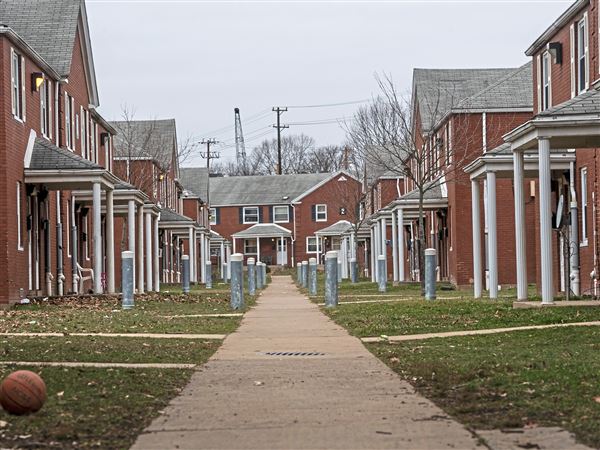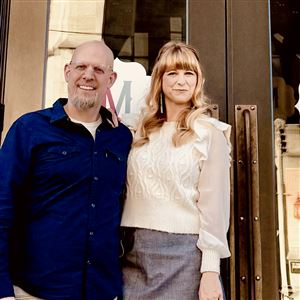
Items found at 516 Sampsonia Way.
Click photo for larger image.
an installation by Ruth Stanford
 Where: 516 Sampsonia Way, North Side. Visitors go first to Mattress Factory museum, 500 Sampsonia Way.
Where: 516 Sampsonia Way, North Side. Visitors go first to Mattress Factory museum, 500 Sampsonia Way. Tickets: $8; $5 for students and seniors; free for museum members and children under 6.
Tickets: $8; $5 for students and seniors; free for museum members and children under 6.
 Information: 412-231-3169 or www.mattress.org
Information: 412-231-3169 or www.mattress.org
 Hours: 10 a.m.-5 p.m. Saturdays; 1-5 p.m. Sundays, through Oct. 22.
Hours: 10 a.m.-5 p.m. Saturdays; 1-5 p.m. Sundays, through Oct. 22.




To most people, 516 Sampsonia Way looks like a lot of other down-on-their-luck row houses in the North Side, a "before" photo that may never rate an "after."
But to artist Ruth Stanford, this century-old, wood-frame house holds all the excitement of an archaeological dig, filled with artifacts and clues to the people who have lived there.
She is so taken with the house that she has used it twice, the exterior for "What Remains" and the interior for "In the Dwelling-House," a Mattress Factory museum exhibition that will be open weekends through Oct. 22.
"This is really an interesting and amazing place," said Ms. Stanford, 42. "There's so much here already. What could I do as an artist to get people to go through and really look?"
After a year of work, this is her answer. Armed with small flashlights and wearing hard hats, visitors see crazed and flaking plaster and paint, exposed plumbing, footprints (both human and animal) and peanut shells, newspapers and other flotsam of daily life, carefully collected in little jars and on display.
If you find yourself making mental notes of all the old-house problems that need to be fixed -- there are too many to count -- then you're missing the point. Look instead with the eyes of an archaeologist who just stumbled into King Tut's tomb -- or of a Southern artist dropped into a Rust Belt row house.
When a visitor comments on the interesting texture of crackled paint on the front door (house painters call it alligatoring), Ms. Stanford says: "Just wait. It's everywhere!"
Of all the detritus the house holds, the artist's obvious favorite is the wallpaper -- in scraps, layers or entire rooms. Several times, she was inspired to create sculptures that amplify some part of the paper's pattern or image, drawing the viewer back to look again at the original.
What does the 1930s-era geometric wallpaper in the kitchen tell us about the person or people who chose it? The Cooper-Hewitt Museum in New York told Ms. Stanford the pattern was particularly popular with Eastern Europeans. It inspired her to make a colorful cubist sculpture from wood.
To make sure visitors don't miss the details, Ms. Stanford and an assistant have drawn tiny frames around some artifacts and provided a room-by-room exhibition guide dotted with pointing fingers.
As a reporter, an art critic and others wandered through the house, shining flashlights, squinting, talking and pointing, Ms. Stanford looked on approvingly.
"This is exactly what I want people to do," she said.
In an artist's statement, she wrote: "The abandoned rooms are filled with information about people none of us know, and a time we never experienced. My interest is in what we may learn about ourselves from considering what they left behind."
She celebrates things the typical home buyer or contractor might consider for a moment before erasing with a hammer, paint brush or plaster knife. Her appreciation is shaped by the contrast between urban Pittsburgh and the ranch-style suburbia of Greenville, Miss., where she grew up.
"I grew up in the South, a really different world," she said. "The physical presence of history in this town is unbelievable. This is a house for workers, yet it has this elegance."
Of course, she had to learn to love Pittsburgh. When she moved here in 2001 to get a master's degree in fine art from Carnegie Mellon, she lived in Squirrel Hill and, later, Lawrenceville.
"At first, I wondered how people live here -- so tight, nothing green. But on summer evenings, everyone is sitting on the porch. It's wonderful."
Her first exhibition at the house, "What Remains," was part of her master's thesis in 2004. The Mattress Factory loaned her the house, just down the alley from the museum. Drawing on information from a house history by Carole Peterson, Ms. Stanford had the names of early occupants carved into granite slabs that fill the window frames.
Listed with the names are the residents' ages and occupations as recorded in old censuses. "Allesandro Cottichius, marble cutter, age 29" is one of her favorites.
"The marble cutter really got me. He kind of inspired this," Ms. Stanford said.
The granite tablets are still in place on the house's exterior, offering something of a preview to what's inside. But "In the Dwelling-House" focuses on later generations of occupants.
One of the most cryptic parts of the installation is a second-floor room that holds an old ragged sofa and a 1950s-era black-and-white television that continually shows slow-motion footage of the "Thrilla in Manila," a legendary 1975 boxing match between Muhammad Ali and Joe Frazier.
Visitors understand a little better when they discover a faded newspaper photo of the fight glued to the wall of a third-floor room. But no one -- including the artist who brought in the TV and sofa -- can say why someone posted that photo years ago, or why it remained there.
Ms. Stanford is much more interested in raising questions than answering them. On one wall, she has copied in luminescent paint a passage from an essay by Ralph Waldo Emerson that provided her work's title:
"Is it not plain that not in senates, or courts, or chambers of commerce, but in the dwelling-house must the true character and hope of the time be consulted? ... "
Correction/Clarification: (Published June 20, 2006) The hours for "In the Dwelling-House," an installation by Ruth Stanford at the Mattress Factory, were left out of this story as originally published for June 17, 2006. They are 10 a.m. to 5 p.m. Saturdays and 1 to 5 p.m. Sundays, through Oct. 22.
First Published: June 17, 2006, 4:00 a.m.
















